By New York Restoration Project
Header image: Taji, community gardener at Willis Avenue Community Garden.
July is National Park and Recreation Month, a time for us to recognize and appreciate the many ways our parks and open spaces benefit us. As we look back over the past year, we have extra reason to be thankful for our green spaces. They not only provided safe places for us to gather, relax, and recreate – many of them transformed into centers of food production, impromptu community centers, and outdoor classrooms. The dual purposes served by our parks helped make our communities stronger, more vibrant, and more resilient throughout the COVID-19 pandemic.
At New York Restoration Project, we partner with community members across the five boroughs to steward 52 community gardens in some of New York’s least green neighborhoods, and we work especially hard to make sure these spaces are activated in a way that is guided by local priorities and input. Depending on our garden members’ interest, a space might focus on food production, cultural programming, education – or all of the above. The result is a diverse array of publicly accessible gardens meeting real community needs.
Read on to learn more about the different ways community members and partners utilize NYRP’s gardens to strengthen communities:
Urban Agriculture
One of the most serious impacts of the COVID-19 pandemic in New York City was the heightened food insecurity it created. At the height of the pandemic, roughly 40% of the City’s emergency food providers shut down due to lack of staff and resources; most of these pantries and soup kitchens were located in incredibly high-needs neighborhoods. Those that remained open reported enormous increases in visitors each week, many of whom were first-time pantry users.
NYRP gardeners responded by growing more food and distributing it to the community.
“There’s a bunch of families in the neighborhood, especially during this time, where a lot of food pantries are stretched,” says Taji, a member at Willis Avenue Community Garden in The Bronx. “Having the community garden be open is really important.”
With support from NYRP (including raised bed construction, seed and plant starts, and technical assistance), community gardeners grew over 90,000 pounds of fresh produce for themselves, their families, and their neighbors. Partnerships with local pantries were created by gardeners at Seagirt Boulevard, Willis Avenue, Essex Street, and Green Acres community gardens, among many others.
“I save my money and my food has better flavor,” says Elvia, another Willis Avenue gardener. “And I like that [the park] is beautiful.”
Health & Wellness
Parks and gardens are inherently healthy spaces – they offer fresh air and encourage physical activity, not to mention healthy eating. For Kele, a retired Transit Authority worker, chef, and gardener at Williams Avenue Community Garden in Brooklyn, her raised bed is an outdoor classroom for imparting nutrition education to her neighbors.
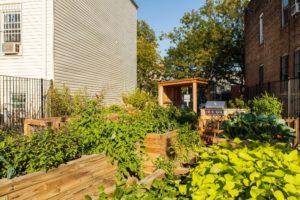
Above: Williams Avenue Garden (photo credit: Anna Yatskevich)

Above: Kele, community gardener at Williams Avenue Community Garden.
“For me, it’s an opportunity to educate my community about eating fresh, seasonal, local, and trying to fight all the diet-related diseases that are affecting our community,” she says.
NYRP’s gardens promote health in other ways besides food production. At Bathgate Community Garden in the Bronx, members recently hosted a free health fair for the local community that included COVID-19 tests and vaccinations as well as blood pressure, cholesterol, and glucose screenings. Throughout the pandemic, members of Essex Street Community Garden partnered with local elected officials to distribute personal protective equipment (PPE) such as face masks and hand sanitizer.
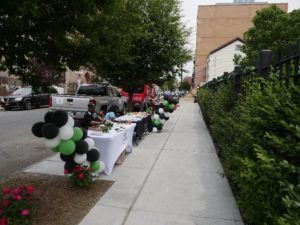
Above: Health Fair at Bathgate Community Garden, May 2021.
Kids, Families & Education
Parks and gardens offer ample opportunity for outdoor education – whether it’s learning how food grows, identifying native plants and animals, or simply enjoying story-time under the shade of a tree. Fortunately, many of NYRP’s community gardens are located within short distance of a school, and classes regularly make use of our spaces for learning and extracurricular activities.

Above: A student tour at Riley-Levin Children’s Garden.
Riley-Levin Children’s Garden hosts hundreds of students from nearby schools, including P.S. 5 Ellen Lurie School, the Washington Heights and Inwood Music Community Charter School, and the Washington Heights Expeditionary Learning School. Students can harvest vegetables in the garden’s raised beds, then learn about Manhattan’s waterfront ecosystem at the adjacent Sherman Creek Park, which includes a restored salt marsh and oyster reef. Gardens with performance spaces, like 103rd Street Community Garden in East Harlem, invite theater companies and other groups to bring family-friendly performances to their space, while others like Willis Avenue Community Garden serve as informal, open-air museums of local ethnic culture.
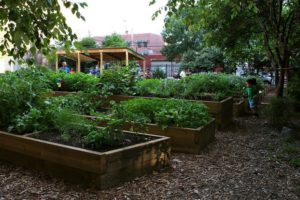
Above: Willis Avenue Community Garden.
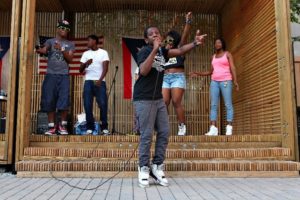
Above: Performance at Willis Avenue Community Garden (photo credit: Emily Kinsolving).
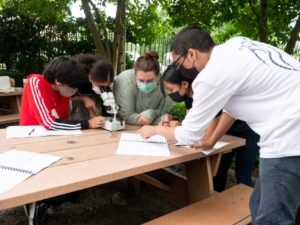
Above: Students from the Washington Heights Expeditionary Learning School (WHEELS) study samples taken from the salt marsh at Sherman Creek Park.
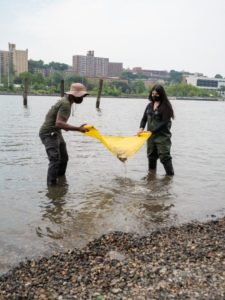
Above: Students from the Washington Heights Expeditionary Learning Schools (WHEELS) seining the salt marsh at Sherman Creek Park.
Building Community
Finally, whatever the focus of a garden, the true underlying purpose is the building of community. Gardens offer neighbors a venue for socializing, working together, discussing their common concerns and brainstorming approaches to community issues. They are fundamentally democratic spaces in which New Yorkers of diverse economic and ethnic backgrounds interact, get to know one another, and become friends.
“It’s a shared space, so that’s one of the other benefits of gardening, is it brings people out in community,” says Greg of Imani Community Garden in Brooklyn. “It’s a joyous experience.”
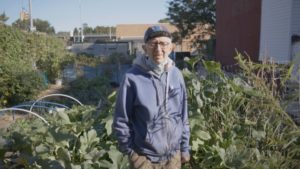
Above: Greg, community gardener at Imani Community Garden.
You can read more about all of New York Restoration Project’s 52 community gardens here, and learn about upcoming community events by checking out our calendar, Facebook, Twitter, or Instagram accounts.
